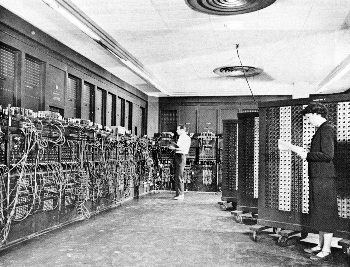ENIAC (Electronic Numerical Integrator And Computer)
The
first all-electronic computer
Common
clues:
Granddaddy of digital computers; 1940s computer; First electronic
computer; Digital dinosaur; Pioneer computer; Early
computer
Crossword
puzzle frequency:
3 times a year
Video: ENIAC
Where a calculator like the ENIAC today is equipped with 18,000 vacuum tubes and weighs 30 tons, computers in the future may have only 1,000 vacuum tubes and perhaps weigh 1.5 tons ~ Popular Mechanics 1949
ENIAC, short for Electronic Numerical Integrator And Computer, was the first all-electronic computer designed to be Turing-complete, capable of being reprogrammed by rewiring to solve a full range of computing problems. It was preceded in 1941 by the fully tape-programmable but still mechanical Z3 designed by Konrad Zuse and by the all-electronic rewire-to-reprogram but not fully general purpose British Colossus computer. Both ENIAC and Colossus used thermionic valves, that is, vacuum tubes, while Z3 used mechanical relays. The requirement to rewire to reprogram ENIAC was removed in 1948.

ENIAC
was developed and built by the U.S. Army for their Ballistics
Research Laboratory with the purpose of calculating ballistic
firing tables. ENIAC was conceived of and designed by J. Presper
Eckert and John William Mauchly of the University of Pennsylvania.
The computer was commissioned on May 17, 1943 as Project
PX,
constructed at the Moore School of Electrical Engineering from
mid-1944, and formally operational from February 1946 having cost
almost $500,000. It was then shut off on November 9, 1946 for a
refurbishment and a memory upgrade. ENIAC was unveiled on February
14, 1946 at the University of Pennsylvania and was transferred to
the Aberdeen Proving Grounds, Maryland in 1947. There, on July
29th of that year, it was turned on and would be in continuous
operation until 11:45 PM on October 2, 1955.
ENIAC used ten-position ring counters to store digits. Arithmetic was performed by "counting" pulses with the ring counters and generating carry pulses if the counter "wrapped around", the idea being to emulate in electronics the operation of the digit wheels of a mechanical adding machine. ENIAC had twenty ten-digit signed accumulators and could perform 5,000 simple addition or subtraction operations between any selected pair of them every second (Note: It was possible to connect several pairs of accumulators simultaneously, so the peak speed of operation was potentially much higher due to parallel operation).
Physically ENIAC was a monster—it contained 17,468 vacuum tubes, 7,200 crystal diodes, 1,500 relays, 70,000 resistors, 10,000 capacitors and around 5 million hand-soldered joints. It weighed 30 short tons (27 t), was roughly 2.4 m by 0.9 m by 30 m, took up 167 m² and consumed 160 kW of power. Input was possible from an IBM card reader, while an IBM card punch was used for output. These cards could be used to produce printed output offline using an IBM accounting machine, probably the IBM 405.
As of 2004, a chip of silicon measuring 0.02 inches (0.5 mm) square holds the same capacity as the ENIAC, which occupied a large room.
This article is licensed under the GNU Free Documentation License. It uses material from the Wikipedia article "ENIAC".
|
|